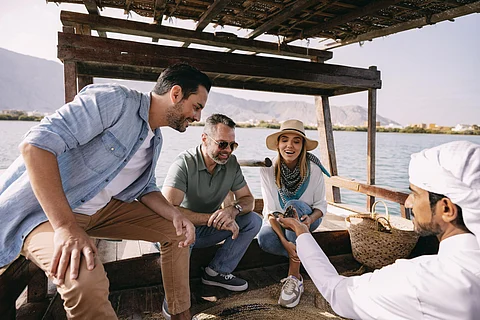
- Destinations
- Experiences
- Stay
- What's new
- Celebrating People
- Responsible Tourism
- CampaignsCampaigns
- Subscribe
- Buy Now

Beneath the afternoon sun, our motorised wooden dhow glides away from the jetty towards a charming wooden deck nestled in the heart of a lagoon. Short cruises on traditional pearl fishing boats offer an engaging glimpse into Ras Al Khaimah’s (RAK) pearl industry, starting from Al Rams. I am set to explore the illustrious Suwaidi Pearl Farm, where the art of pearl fishing has flourished for over seven millennia. Founded by Abdulla Rashed Al Suwaidi in honour of his late grandfather Mohammed (in 2004), this farm in the quaint fishing village of Al Rams, located in the northern reaches of RAK and nestled at the foothills of the stunning Jebel Jais mountains, offers a unique glimpse into a lost world and showcases the exquisite beauty of pearls while celebrating a rich family legacy amid breathtaking landscapes. Long before oil reigned supreme, the fortunes were spun from fishing and the ancient art of pearling. What a delightful dive into history!
While the pearl industry has shifted dramatically from traditional diving to modern farming, Suwaidi Pearl Farm is pioneering in this evolution. Imagine young Suwaidi, wide-eyed with wonder, as he watched his father and grandfather embark on daring voyages, sometimes disappearing for months, their safe return uncertain. Pearling was more than a perilous job; it was the lifeblood of coastal living. At its peak, this captivating tradition employed around 22,000 men across the emirates.
Archaeologist Robert Carter notes in his book "Sea of Pearls" that 65-80 per cent of the world’s pearls once came from the Gulf, with those from Bahrain and Ras Al Khaimah shining as the crème de la crème. However, the 1930s brought a downturn as commercial pearling declined, overshadowed by cheaper cultured alternatives, forcing traditional divers like the Suwaidis into early retirement. The remnants of this golden era linger in whispered tales and fragmented memories. Determined to preserve this shimmering legacy, Suwaidi opened his pearl farm, inviting visitors to dive deep into the storied history and revel in the bygone brilliance of pearling—transforming the farm into a captivating time capsule of noble heritage.
My fascination with pearl diving began much earlier, and I have devoured several articles on the subject. As our boat drifted further into the lagoon, the jetty’s buildings blurred into hazy silhouettes, leaving the dramatic Hajar mountains and lush mangroves to dominate the horizon’ I finally had a chance to dive deeper—figuratively. Onboard, large maps, illustrated exhibits, and photographs vividly captured the nuances of the trade. Obaid, our guide, unravelled the history, the heydays, the downfall, and the farm’s current projects for the next hour and a half.
We discovered that the prime pearling season spanned from May to August. During this period, wooden dhows would set sail, staying at sea for weeks. Without advanced equipment, divers relied on precise systems to plunge into the mysterious depths in search of pearls. Each diver had a dedicated haulier who held onto a rope, ready to hoist them upon receiving a signal—usually a simple tug. Dives lasted no more than two or three minutes, with divers making 50 to 200 dives daily. It’s a breathtaking testament to human endurance and the allure of the ocean’s hidden treasures.
As Obaid’s knife slid through the shell, a palpable tension filled the air as we collectively held our breath. However, our excitement quickly deflated when only the lifeless remains of the oyster greeted us. ‘In 99 % of cases, the shells come up empty,’ Obaid warned, pouring cold water on our anticipation. Yet, he wasn’t finished; he sliced through the creature with a deft flick of his knife. “Behold! This is the heart of the oyster,” he proclaimed, igniting our fascination. Quickly, he unearthed a tiny orb nestled within its insides. To our astonishment, a brilliant pearl sparkled in his palm! We gasped with surprise and joy, marvelling at the chance to witness my first fresh pearl.
Imagine the incredible odds: it takes 1,000 oysters to yield just 10 pearls—one large and nine petite. Each pearl’s worth is sentimental and commercial, meticulously graded on size, colour, surface quality, lustre, and shape. But what makes these gems so rare? The answer lies in a delicate dance of nature. When an oyster’s mantle is injured by a parasite or attacked by a crab, it begins healing, forming a cyst that eventually crystallises into a shimmering pearl. In days gone by, after dawn prayers, divers would open the oysters gathered from the previous day, meticulously washing, grading, and sorting their treasures. What are the biggest markets for these pearls? Mumbai and Europe.
Fast forward to today, and we are in this traditional Arabic majlis at the Suwaidi Pearl Farm. Next, Obaid captivates us with a wooden box of small red pouches and tools once used to evaluate these oceanic wonders. He unties a pouch with nimble fingers, spilling a rainbow of pearls onto a vivid red cloth. As we conclude our visit in a charming showroom by the jetty—displaying pearls from Ras Al Khaimah, I resist the urge to splurge but leave with my heart brimming with tales of adventurous voyages, skilled divers, and a nearly extinct profession that once thrived beneath the waves. This experience wasn’t just a glimpse into nature’s treasure and a journey through time and heritage.
Cost: Approx. INR 6,000 per person, including the dhow transfers and a local lunch.
For more information, visit suwaidipearls.ae.
